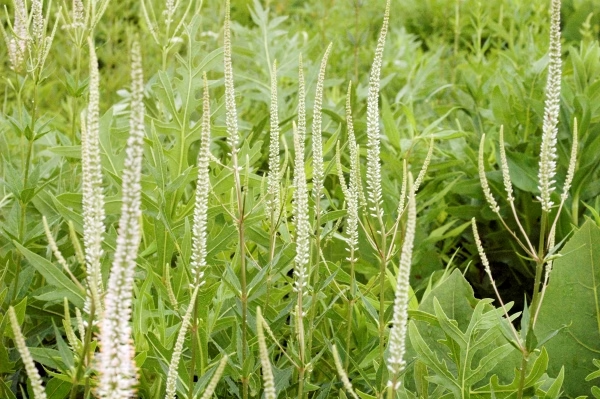
Culver’s Root
Botanical Name
:
Veronicastrum virginicum
Plant Type
:
Herbaceous perennial
Seasons
:
Plant in spring or fall; blooms in summer (July–September)
Sun Level
:
Full sun (at least 6 hours daily) to light shade
Ideal Soil Temperature for Planting
:
65–75°F (18-24°C)
Soil Type
:
Moist, well-drained soil; tolerates some clay
Hardiness Zones
:
3–8 (USDA)
Germination
:
Seeds can be sown directly in the garden in spring or started indoors 6-8 weeks before the last frost
P.H. Level
:
Neutral to slightly acidic (6.0–7.0)
Water/Irrigation
:
Needs consistent moisture, especially during the first year. Once established, it is relatively drought-tolerant
Fertilization
:
Generally not needed, but a light application of a balanced 10-10-10 fertilizer in spring can be beneficial
Habit
:
Erect, upright, unbranched (or sparsely branched)
Propagation
:
Seed, division (in spring or fall)
Final Plant Height
:
2–6 ft
Spread
:
1–2 ft
Flowers
:
Tall, slender spikes of small, densely packed white, pink, or pale purple flowers
Attracts
:
Bees, butterflies, and other pollinators
Uses
:
Borders, cottage gardens, rain gardens, naturalized areas
Companions
:
Plants that prefer similar conditions, such as coneflowers (Echinacea), asters, and ornamental grasses
Pruning
:
Deadhead spent flowers to prevent self-seeding (though it’s not overly aggressive). Cut back stems in late fall or early spring
Toxicity
:
Non-toxic to humans and pets
Pests
:
Generally pest-free
Diseases
:
Powdery mildew (especially in humid climates)
Fun Fact
:
The name Culver’s Root comes from Dr. Culver, an 18th-century physician who reportedly used the plant medicinally, primarily as a laxative. Indigenous peoples also used it for various medicinal applications, including digestive health
Confused With
:
Other tall, white-flowered perennials, though the flower structure is quite distinctive
Additional Info
:
It’s a long-lived perennial that returns reliably each year with minimal maintenance
Botanical Name
:
Veronicastrum virginicum
Plant Type
:
Herbaceous perennial
Seasons
:
Plant in spring or fall; blooms in summer (July–September)
Sun Level
:
Full sun (at least 6 hours daily) to light shade
Ideal Soil Temperature for Planting
:
65–75°F (18-24°C)
Soil Type
:
Moist, well-drained soil; tolerates some clay
Hardiness Zones
:
3–8 (USDA)
Germination
:
Seeds can be sown directly in the garden in spring or started indoors 6-8 weeks before the last frost
P.H. Level
:
Neutral to slightly acidic (6.0–7.0)
Water/Irrigation
:
Needs consistent moisture, especially during the first year. Once established, it is relatively drought-tolerant
Fertilization
:
Generally not needed, but a light application of a balanced 10-10-10 fertilizer in spring can be beneficial
Habit
:
Erect, upright, unbranched (or sparsely branched)
Propagation
:
Seed, division (in spring or fall)
Final Plant Height
:
2–6 ft
Spread
:
1–2 ft
Flowers
:
Tall, slender spikes of small, densely packed white, pink, or pale purple flowers
Attracts
:
Bees, butterflies, and other pollinators
Uses
:
Borders, cottage gardens, rain gardens, naturalized areas
Companions
:
Plants that prefer similar conditions, such as coneflowers (Echinacea), asters, and ornamental grasses
Pruning
:
Deadhead spent flowers to prevent self-seeding (though it’s not overly aggressive). Cut back stems in late fall or early spring
Toxicity
:
Non-toxic to humans and pets
Pests
:
Generally pest-free
Diseases
:
Powdery mildew (especially in humid climates)
Fun Fact
:
The name Culver’s Root comes from Dr. Culver, an 18th-century physician who reportedly used the plant medicinally, primarily as a laxative. Indigenous peoples also used it for various medicinal applications, including digestive health
Confused With
:
Other tall, white-flowered perennials, though the flower structure is quite distinctive
Additional Info
:
It’s a long-lived perennial that returns reliably each year with minimal maintenance
Written by Nondiah Khalayi – https://www.linkedin.com/in/nondiah-khalayi/

